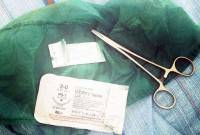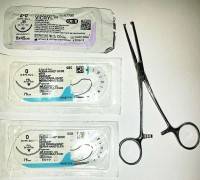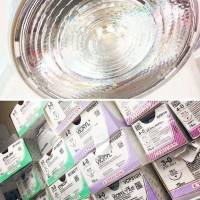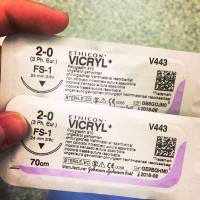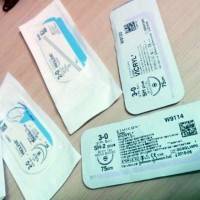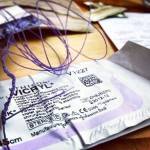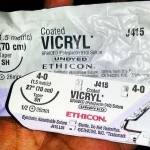Tummy tuck sutures
There are many ways to close an abdominoplasty incision. Ideally the surgeon chooses the sutures and places them in such a way that the wounds heals without any problem.
On occasion a suture can work it’s way though the skin, usually it is not a true allergy.
In my practice we use vicryl suture in a deeper layers, in a more superficial layer we use a different type of an absorbing suture that rarely is “spit”. (Boris M. Ackerman, MD, Newport Beach Plastic Surgeon)
Tummy tuck sutures are divided into groups such as :
– Dissolving VS. Non-dissolving (“permanent)
– Smooth (mono-filament) VS Braided (like ropes)
Braided sutures are easier to tie BUT have a higher rate of being pushed out by the body. This happens more frequently the closer the stitches are placed near the surface. Vicryl is a braided dissolving sutures that has many positive attributes but one of its weaknesses it that it tends to “spit” – be pushed out by the body when superficial.
When this happens the stitch can literally be pulled out and the opening can fully heal in days. (Peter A. Aldea, MD, Memphis Plastic Surgeon)
With a tummy tuck, many sutures are placed. Some of these sutures don’t quite dissolve, and the body encapsulates them and then tries to get rid of them. These sutures may be seen to be “spitting” out of the wound. Vicryl is supposed to be mostly broken down in the body by 6 weeks.
As everyone is different, this may not always be the case. True allergic reactions are rare, but they can happen. Please see your plastic surgeon for appropriate treatment. For spitting sutures, your plastic surgeon will usually be able to take these out as they get to the surface. Please let him/her do this. No bathroom surgery please! (Jeffrey Roth, MD, Las Vegas Plastic Surgeon)
It’s possible to have an allergy, but the most common problem seen with braided sutures, like Vicryl, is a little localized infection of normal skin bacteria around the knots that form individual pustules. These are easily treated by your doctor by simple removal. (Randy J. Buckspan, MD, Austin Plastic Surgeon)
Stitch problems after tummy tuck can happen, and can be fixed
An allergy to vicryl is very rare, but it is quite common to have spitting stitches or stitch abscesses after using vicryl (and other types of suture, too, not just vicryl). The removal of the stitches should fix the problem and improve your wound healing. (Carmen Kavali, MD, Atlanta Plastic Surgeon)
A true allergy to Vicryl sutures is rare.
A true allergy to Vicryl sutures is rare; it is more common to have small “stitch abscesses” from Vicryl and is not uncommon after larger procedures.
Vicryl sutures are normally absorbed/dissolved by your body but sometimes the bulk of suture where the knots are tied is simply too much for your body to absorb and therefore your body tries to eliminate it by “spitting” the stitch out through the skin. Some individuals tend to “spit stitches” more than others.
Sometimes this can be caused by bacteria which enter into the stitch and create small infections around the stitch which burst like small acne sores and then get better spontaneously. This is usually nothing to be worried about, and is seen frequently with some other dissolving sutures as well. (Richard H. Fryer, MD, Salt Lake City Plastic Surgeon)
Allergic reaction to Vicryl sutures after a tummy tuck
Vicryl is a suture that is braided and will eventually absorb. Traditionally, it has been used by general surgeons and is commonly used to close wounds in a deep layer.
Unfortunately, when Vicryl is used just under the skin, it is common for it to stimulate an immune response from your body which can look like redness or a mild infection. In actuality, it is your body trying to break down the suture and spit the Vicryl out of your body. This can cause discomfort and concern in patients.
For this reason, we are not used to Vicryl suture in the skin for more than 10 years. There are currently other better sutures that can provide the same strength as Vicryl but not this inflammatory reaction. Return your surgeon and showing the area you’re concerned with and let him know of your concerns. If you routinely uses suture will be expecting this. (Pat Pazmino, MD, Miami Plastic Surgeon)
This occurs in some patients, why I am not quite sure. I have started using other tummy tuck sutures but most patients have no problem with either suture. Although it is annoying these pustules that form will “spit” out the suture remnant and resolve. If several months after they stop spitting you still have some scarring that is unfavorable your plastic surgeon may want to do a minor touch up under local anesthesia – but this is rarely needed. (Steven Schuster, MD, Boca Raton Plastic Surgeon)
Tummy tuck sutures spitting
Tummy tuck sutures are very common materials to use to close wouns. They usually dissolve on their own. But, they can “spit” or make their way through the skin and causes little blisters. They usually heal without significant sequelae. (Steven Wallach, MD, Manhattan Plastic Surgeon)
Vicryl is broken down by the body and eventually absorbed over the process of six weeks or longer. As this happens, sometimes patients develop “suture abcesses”. This is somewhat unpredictable, but when it does occur, it can cause widened, hypertrophic scars in the area. I do not use Vicryl because of the frequency of this type of reaction. (W. Tracy Hankins, MD, Las Vegas Plastic Surgeon)
Am I allergic to tummy tuck sutures?
I agree this sounds like a stitich “abscess”. It can happen around any type of suture material. You physician can treat this easily in the office. When patients have an allergy to suture material, the skin usually becomes very red and itchy and does not have small areas of pus. (Tracy Pfeifer, MD, Manhattan Plastic Surgeon)
- Tummy tuck operation sutures photo
- Tummy tuck operation sutures
- Tummy tuck surgery sutures
- Tummy tucks sutures
Reaction to Tummy tuck sutures
When this happens this is not an allergy really, but the way a person’s body processes the suture. These sutures dissolve and as they do some some people’s bodies kinda “spit them out.” I vary the types of sutures used in these cases especially when I see this. It seems to happen more with Vicryl than other sutures, so I use less Vicryl these days. (John P. Di Saia, MD, Orange Plastic Surgeon)

